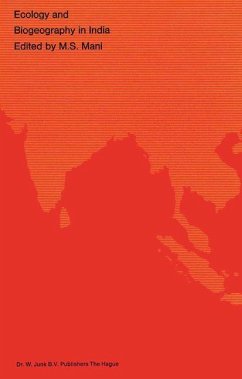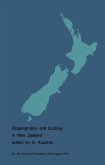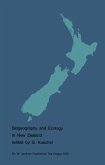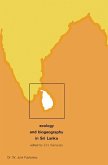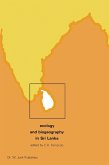- Gebundenes Buch
- Merkliste
- Auf die Merkliste
- Bewerten Bewerten
- Teilen
- Produkt teilen
- Produkterinnerung
- Produkterinnerung
This book describes the outstanding features of the ecology and bio geography of the Indian region, comprising former British India, Nepal, Bhutan, Ceylon and Burma. It summarizes the results of nearly four decades' studies and field explorations and discussions with students on the distribution of plants and animals, practically throughout this vast area and on the underlying factors. A number of specialists in geology, meteorology, botany, zoology, ecology and anthropology have also actively collaborated with me and have contributed valuable chapters in their respective fields. India has an…mehr
Andere Kunden interessierten sich auch für
![Ecology and Biogeography in India Ecology and Biogeography in India]() Ecology and Biogeography in India317,99 €
Ecology and Biogeography in India317,99 €![Biogeography and Ecology in New Zealand Biogeography and Ecology in New Zealand]() G. Kuschel (ed.)Biogeography and Ecology in New Zealand156,99 €
G. Kuschel (ed.)Biogeography and Ecology in New Zealand156,99 €![Biogeography and Ecology in New Zealand Biogeography and Ecology in New Zealand]() Biogeography and Ecology in New Zealand43,99 €
Biogeography and Ecology in New Zealand43,99 €![Ecology and Biogeography in Sri Lanka Ecology and Biogeography in Sri Lanka]() Ecology and Biogeography in Sri Lanka42,99 €
Ecology and Biogeography in Sri Lanka42,99 €![Ecology and Biogeography in Sri Lanka Ecology and Biogeography in Sri Lanka]() C.H. Fernando (ed.)Ecology and Biogeography in Sri Lanka112,99 €
C.H. Fernando (ed.)Ecology and Biogeography in Sri Lanka112,99 €![Biogeography and Ecology in Madagascar Biogeography and Ecology in Madagascar]() Biogeography and Ecology in Madagascar156,99 €
Biogeography and Ecology in Madagascar156,99 €![Biogeography and Ecology in Madagascar Biogeography and Ecology in Madagascar]() Biogeography and Ecology in Madagascar134,99 €
Biogeography and Ecology in Madagascar134,99 €-
-
-
This book describes the outstanding features of the ecology and bio geography of the Indian region, comprising former British India, Nepal, Bhutan, Ceylon and Burma. It summarizes the results of nearly four decades' studies and field explorations and discussions with students on the distribution of plants and animals, practically throughout this vast area and on the underlying factors. A number of specialists in geology, meteorology, botany, zoology, ecology and anthropology have also actively collaborated with me and have contributed valuable chapters in their respective fields. India has an exceptionally rich and highly diversified flora and fauna, exhibiting complex composition, character and affinities. Although the fauna of the Indian region as a whole is less completely known than its flora, we are nevertheless fairly well acquainted with at least the salient features of its faunal characters to enable us to present a meaningful discussion on some of the outstanding peculiarities of the biogeography of India. A general synthesis of the available, though much scattered, information should prove useful to future students of biogeography throughout the world.
Hinweis: Dieser Artikel kann nur an eine deutsche Lieferadresse ausgeliefert werden.
Hinweis: Dieser Artikel kann nur an eine deutsche Lieferadresse ausgeliefert werden.
Produktdetails
- Produktdetails
- Monographiae Biologicae 23
- Verlag: Springer / Springer Netherlands
- Artikelnr. des Verlages: 978-90-6193-075-4
- Seitenzahl: 816
- Erscheinungstermin: 30. Juni 1974
- Englisch
- Abmessung: 241mm x 160mm x 48mm
- Gewicht: 1368g
- ISBN-13: 9789061930754
- ISBN-10: 9061930758
- Artikelnr.: 23437418
- Herstellerkennzeichnung Die Herstellerinformationen sind derzeit nicht verfügbar.
- Monographiae Biologicae 23
- Verlag: Springer / Springer Netherlands
- Artikelnr. des Verlages: 978-90-6193-075-4
- Seitenzahl: 816
- Erscheinungstermin: 30. Juni 1974
- Englisch
- Abmessung: 241mm x 160mm x 48mm
- Gewicht: 1368g
- ISBN-13: 9789061930754
- ISBN-10: 9061930758
- Artikelnr.: 23437418
- Herstellerkennzeichnung Die Herstellerinformationen sind derzeit nicht verfügbar.
Chapters' Contents.- I. Introduction.- II. Physical Features.- 1. The Peninsula.- 1.1. The Peninsular Plateau.- 1.2. The Peninsular Foreland.- 1.3. The Coastal Regions.- A. The Western Littoral Region.- B. The Eastern Littoral Region.- 1.4. Ceylon.- 2. The Extra-Peninsular Area.- 2.1. The Ranges of the Himalaya.- 2.2. The Geographical and Biogeographical Divisions of the Himalaya.- 3. The Indo-Gangetic Plains.- 4. The Soil.- 5. The Drainage.- 5.1. The Peninsular Rivers.- 5.2. The Extra-Peninsular Rivers.- 5.3. Changes in the course and evolution of the Drainage Patterns of the Extra-Peninsular Rivers.- 6. Natural Regions.- References.- III. Geology.- 1. General Structure.- 1.1. The Peninsular Area.- 1.2. The Extra-Peninsular Area.- A. The Himalayan Arc.- B. The Burmese Arc.- C. The Baluchistan Arc.- 2. Pre-Cambrian Eras.- 2.1. Kerala.- 2.2. Madras.- 2.3. Mysore.- 2.4. Rajasthan.- 2.5. Southern Bihar and Orissa.- 2.6. The Eastern Ghats.- 2.7. Assam.- 2.8. Cuddapah Basin.- 2.9. The Himalayan Area.- 3. The Palaeozoic Era.- 3.1. Lower Palaeozoic.- 3.2. Devonian System.- 3.3. Carboniferous System.- 3.4. The Gondwana Group.- 3.5. The Permian System.- 4. The Mesozoic Era.- 4.1. Triassic System.- 4.2. Jurassic System.- 4.3. Cretaceous System.- 4.4. Deccan Trap.- 5. The Tertiary Era.- 5.1. Eocene System.- 5.2. Oligocene and Lower Miocene.- 5.3. Middle Miocene to Lower Pleistocene.- 6. Pleistocene and Recent.- References.- IV. Weather and Climatic patterns.- 1. Introduction.- 2. Normal Seasonal and Annual Rainfall.- 3. The Indian Monsoon.- 3.1. The Dates of Establishment of the Monsoon.- 3.2. The Behaviour of the Southwest Monsoon during 1875-1950.- 3.3. Rainfall week by week during the year.- 3.4. Contemporary relationships of the Monsoon rainfall in fifteen divisions.- 3.5.Regional peculiarities of distribution of rainfall.- 4. Other important Weather Phenomena that bring rainfall.- 4.1. The Eastern Depression.- 4.2. The Western Depressions.- 4.3. Cyclonic Storms.- 4.4. Thunderstorms and Hailstorms.- 5. Cold and Heat Waves.- 6. Microclimatology.- 6.1. Solar and Terrestrial Radiation.- 6.2. The Ground as Active Surface.- 6.3. The Diurnal temperature range.- 6.4. Shimmering layer above ground.- 6.5. Invisible condensation at soil surface.- 6.6. Thermal balance on a clear day.- 6.7. Microclimate of the open and some typical crop-fields.- A. Some typical microclimates and their diurnal range.- B. Effect of plant communities on wind velocity.- C. Effect of environment on the evaporating power of air layers near the ground.- References.- V. Limiting factors.- 1. Present-day Climate and its relation to the Himalaya.- 1.1. The monsoon-dominated Seasons.- 1.2. The mechanism of the Indian Monsoon.- 2. The Relation between the Himalayan uplift and the biogeographical composition of India.- 3. The Relation between Distributional Patterns and Man.- 3.1. Destruction of habitats.- 3.2. Extermination of Fauna.- 4. Conclusion.- References.- VI. The Flora.- 1. General characters of the Flora.- 2. The Major Floristic groups.- 2.1. Exotic naturalized plants.- 2.2. Tropical Asiatic Elements.- 2.3. The Temperate zone Elements.- 2.4. The Steppes Elements.- 2.5. The Mediterranean Elements.- 2.6. The Tropical African and Madagascan Elements.- 2.7. Pleistocene Relicts.- 3. The Major Ecological groups.- 3.1. Tropical forests.- 3.2. Montane subtropical and Temperate Forests.- 3.3. Alpine Forests.- 3.4. Littoral Forests.- 4. Phytogeographical Divisions.- References.- VII. Vegetation and Phytogeography of the Western Ghats.- 1. Introduction.- 2. History of botanicalstudies in the Western Ghats.- 3. Phytogeographical regions and Vegetation.- 3.1. The Western Ghats from the R. Tapti to Goa.- 3.2. The Western Ghats from the R. Kalinadi to Coorg.- 3.3. The Nilgiri.- 3.4. The Anamalai, Cardamom and Palni Hills.- 4. The Endemic Flora of the Western Ghats.- 5. Acknowledgments.- References.- VIII. The Vegetation and Phytogeography of the Eastern Ghats.- 1. Introduction.- 2. The Northern Sal Division.- 3. The Deccan Division.- 4. The Southern Division.- References.- IX. The Vegetation and Phytogeography of Assam-Burma.- 1. Introduction.- 2. Vegetation of Assam.- 2.1. The Tropical Vegetation.- 2.2. The Temperate Vegetation.- 2.3. The Alpine Vegetation.- 2.4. Some other Interesting Elements of the Assam Flora.- 3. Phytogeographical Affinities of Assam.- 4. Burma.- References.- X. Vegetation and Phytogeography of the Himalaya.- 1. Introduction.- 2. The Northwest Himalaya.- 2.1. Kashmir.- 2.2. Himachal Pradesh.- 3. The Western Himalaya.- 4. The Central Himalaya.- 5. The Eastern Himalaya.- 5.1. Sikkim.- 5.2. Bhutan.- 5.3. Assam and the North-East Frontier Agency.- 6. Phytogeographical Affinities.- References.- XI. The tribal man in India: A study in the Ecology of the primitive communities.- 1. Introduction.- 2. Tribal Society.- 3. Tribal Villages.- 4. Tribal family and Marriage Types.- 5. Tribal Demography.- 6. Regional Distribution of Tribal populations.- 7. Tribal Government.- 8. Interrelations with others.- 9. Cultural-Ecological Adaptations and Changes.- 9.1. Hunters, Fishers and Gatherers.- 9.2. Shifting cultivators.- 9.3. Peasants, Artisans and Castes.- 9.4. Transhumant herders and Terrace Cultivators.- 9.5. Nomadic Groups.- References.- XII. Some examples of recent Faunal Impoverishment and Regression.- 1. Introduction.- 2. Some Vanishing species of Reptiles.- 3. Some Vanishing species of Birds.- 4. Some Vanishing Mammals.- 5. Impoverishment and Regression.- 6. Major Factors determining Faunal Impoverishment and Regression.- References.- XIII. The Ecology of Vertebrates of the Indian Desert.- 1. Introduction.- 2. The Indian Desert.- 3. Fishes.- 4. Amphibians.- 5. Reptiles.- 5.1. Ecological Distribution.- 5.2. Food.- 5.3. Breeding.- 5.4. Zoogeography.- 6. Birds.- 7. Mammals.- 7.1. Ecological Distribution.- 7.2. Food.- 7.3. Reproduction.- 7.4. Population characteristics.- 8. The Vanishing Desert Wildlife.- 9. Behavioural and Physiological Adaptations to the Xeric Environment.- 10. Zoögeography.- References.- XIV. Ecology and Biogeography of the Termites of India.- 1. Introduction.- 2. Some Aspects of the Ecology of Termites in India.- 2.1. Termites and Soil.- 2.2. Termites and Living Plants.- 2.3. Relation between Atmospheric temperature and humidity and Termites.- 2.4. Gravity response and Vertical distribution of Termites.- 2.5. Populations of Termite Colonies.- 2.6. Inquilinism.- 2.7. Termites and Fungi.- 2.8. Natural Enemies of Termites.- 2.9. Termitophile Associates.- 3. Limiting Factors in Distribution of Termites.- 4. Distribution of some important Termites from India.- 4.1. Kalotermitidae.- 4.2. Termopsidae.- 4.3. Hodotermitidae.- 4.4. Rhinotermitidae.- 4.5. Termitidae.- 4.6. Indotermitidae.- References.- XV. The Biogeography of Indian Butterflies.- 1. Introduction.- 2. The faunal centres of Indian butterfly genera.- 3. The Derivation of the Indian butterfly fauna in relation to Continental Drift.- 4. The faunal elements of Indian butterfly species and their relation to the generic centres.- 5. Conclusion.- References.- XVI. Some aspects of the Ecology and Geography of Diptera.- 1.Introduction.- 2. Major Ecological Types.- 2.1. The monsoon Communities.- 2.2. The winter Communities.- 2.3. The Humid-tropical Elements.- 2.4. The Dry Tropical deciduous Forest Communities.- 2.5. The Temperate zone Communities.- 2.6. The Synanthropous Communities.- 3. Nematocera.- 4. Brachycera.- 5. Conclusion.- References.- XVII. Ecology and Distribution of fresh-water Fishes, Amphibia and Reptiles.- 1. Introduction.- 2. Fish.- 2.1. Distributional Patterns of the primary fresh-water fishes.- 3. Amphibia.- 4. Chelonia.- 5. Lacertilia.- 6. Serpentes.- 7. Crocodilia.- 8. Summary.- References.- XVIII. Mammals of Assam and the Mammal-Geography of India.- 1. Introduction.- 2. The major Ecological Associations.- 3. The Faunal composition.- 4. Faunal Resemblance.- 5. Faunal Interchanges.- 6. Species Dispersal.- 6.1. Nature of Invasions.- 7. Criticism of the Satpura Hypothesis.- 8. Mainstreams of the Faunal Flow.- References.- XIX. Biogeography of the Peninsula.- 1. Introduction.- 2. The Character Fauna.- 3. The Gondwana Faunal Derivatives.- 3.1. The Peninsular Endemics.- 3.2. The Madagascan Elements.- 4. The Younger Intrusive Elements.- 4.1. The Indo-Chinese Faunal Derivatives.- 4.2. The Malayan Elements.- 5. The Palaearctic Elements.- 6. Distributional Patterns.- 7. Faunal subdivisions.- 8. The Laccadive and Maladive Islands.- 9. Seychelles Islands.- References.- XX. Biogeography of the Eastern Borderlands.- 1. Ecology.- 2. The Character Fauna.- 2.1. Endemics.- 2.2. The Indo-Chinese and Malayan Elements.- 2.3. Other Component Elements.- 3. Distributional Patterns.- 4. The Andaman and Nicobar Islands.- References.- XXI. Biogeography of the Himalaya.- 1. Introduction.- 2. Fauna of the Forest Zones.- 2.1. The Himalayan Forest east of the R. Sutlej.- 2.2. The Himalayan Forest west of the R. Sutlej.- 3. Fauna above the Forestline.- References.- XXII. Biogeography of the Western Borderlands.- 1. Introduction.- 2. General Ecology.- 3. Character Fauna and Biogeographical Affinities.- References.- XXIII. Biogeography of the Indo-Gangetic Plain.- 1. Introduction.- 1.1. The Indus Plains.- 1.2. The Gangetic Plains.- 1.3. The Upper Gangetic Plain.- 1.4. The Middle Gangetic Plain.- 1.5. Bengal.- 2. Ecology.- 3. Character Fauna and Distributional Patterns.- References.- XXIV. Biogeographical Evolution in India.- 1. Introduction.- 2. The origins of the Flora and Fauna.- 3. The origins of the Distributional Patterns.- References.
Chapters' Contents.- I. Introduction.- II. Physical Features.- 1. The Peninsula.- 1.1. The Peninsular Plateau.- 1.2. The Peninsular Foreland.- 1.3. The Coastal Regions.- A. The Western Littoral Region.- B. The Eastern Littoral Region.- 1.4. Ceylon.- 2. The Extra-Peninsular Area.- 2.1. The Ranges of the Himalaya.- 2.2. The Geographical and Biogeographical Divisions of the Himalaya.- 3. The Indo-Gangetic Plains.- 4. The Soil.- 5. The Drainage.- 5.1. The Peninsular Rivers.- 5.2. The Extra-Peninsular Rivers.- 5.3. Changes in the course and evolution of the Drainage Patterns of the Extra-Peninsular Rivers.- 6. Natural Regions.- References.- III. Geology.- 1. General Structure.- 1.1. The Peninsular Area.- 1.2. The Extra-Peninsular Area.- A. The Himalayan Arc.- B. The Burmese Arc.- C. The Baluchistan Arc.- 2. Pre-Cambrian Eras.- 2.1. Kerala.- 2.2. Madras.- 2.3. Mysore.- 2.4. Rajasthan.- 2.5. Southern Bihar and Orissa.- 2.6. The Eastern Ghats.- 2.7. Assam.- 2.8. Cuddapah Basin.- 2.9. The Himalayan Area.- 3. The Palaeozoic Era.- 3.1. Lower Palaeozoic.- 3.2. Devonian System.- 3.3. Carboniferous System.- 3.4. The Gondwana Group.- 3.5. The Permian System.- 4. The Mesozoic Era.- 4.1. Triassic System.- 4.2. Jurassic System.- 4.3. Cretaceous System.- 4.4. Deccan Trap.- 5. The Tertiary Era.- 5.1. Eocene System.- 5.2. Oligocene and Lower Miocene.- 5.3. Middle Miocene to Lower Pleistocene.- 6. Pleistocene and Recent.- References.- IV. Weather and Climatic patterns.- 1. Introduction.- 2. Normal Seasonal and Annual Rainfall.- 3. The Indian Monsoon.- 3.1. The Dates of Establishment of the Monsoon.- 3.2. The Behaviour of the Southwest Monsoon during 1875-1950.- 3.3. Rainfall week by week during the year.- 3.4. Contemporary relationships of the Monsoon rainfall in fifteen divisions.- 3.5.Regional peculiarities of distribution of rainfall.- 4. Other important Weather Phenomena that bring rainfall.- 4.1. The Eastern Depression.- 4.2. The Western Depressions.- 4.3. Cyclonic Storms.- 4.4. Thunderstorms and Hailstorms.- 5. Cold and Heat Waves.- 6. Microclimatology.- 6.1. Solar and Terrestrial Radiation.- 6.2. The Ground as Active Surface.- 6.3. The Diurnal temperature range.- 6.4. Shimmering layer above ground.- 6.5. Invisible condensation at soil surface.- 6.6. Thermal balance on a clear day.- 6.7. Microclimate of the open and some typical crop-fields.- A. Some typical microclimates and their diurnal range.- B. Effect of plant communities on wind velocity.- C. Effect of environment on the evaporating power of air layers near the ground.- References.- V. Limiting factors.- 1. Present-day Climate and its relation to the Himalaya.- 1.1. The monsoon-dominated Seasons.- 1.2. The mechanism of the Indian Monsoon.- 2. The Relation between the Himalayan uplift and the biogeographical composition of India.- 3. The Relation between Distributional Patterns and Man.- 3.1. Destruction of habitats.- 3.2. Extermination of Fauna.- 4. Conclusion.- References.- VI. The Flora.- 1. General characters of the Flora.- 2. The Major Floristic groups.- 2.1. Exotic naturalized plants.- 2.2. Tropical Asiatic Elements.- 2.3. The Temperate zone Elements.- 2.4. The Steppes Elements.- 2.5. The Mediterranean Elements.- 2.6. The Tropical African and Madagascan Elements.- 2.7. Pleistocene Relicts.- 3. The Major Ecological groups.- 3.1. Tropical forests.- 3.2. Montane subtropical and Temperate Forests.- 3.3. Alpine Forests.- 3.4. Littoral Forests.- 4. Phytogeographical Divisions.- References.- VII. Vegetation and Phytogeography of the Western Ghats.- 1. Introduction.- 2. History of botanicalstudies in the Western Ghats.- 3. Phytogeographical regions and Vegetation.- 3.1. The Western Ghats from the R. Tapti to Goa.- 3.2. The Western Ghats from the R. Kalinadi to Coorg.- 3.3. The Nilgiri.- 3.4. The Anamalai, Cardamom and Palni Hills.- 4. The Endemic Flora of the Western Ghats.- 5. Acknowledgments.- References.- VIII. The Vegetation and Phytogeography of the Eastern Ghats.- 1. Introduction.- 2. The Northern Sal Division.- 3. The Deccan Division.- 4. The Southern Division.- References.- IX. The Vegetation and Phytogeography of Assam-Burma.- 1. Introduction.- 2. Vegetation of Assam.- 2.1. The Tropical Vegetation.- 2.2. The Temperate Vegetation.- 2.3. The Alpine Vegetation.- 2.4. Some other Interesting Elements of the Assam Flora.- 3. Phytogeographical Affinities of Assam.- 4. Burma.- References.- X. Vegetation and Phytogeography of the Himalaya.- 1. Introduction.- 2. The Northwest Himalaya.- 2.1. Kashmir.- 2.2. Himachal Pradesh.- 3. The Western Himalaya.- 4. The Central Himalaya.- 5. The Eastern Himalaya.- 5.1. Sikkim.- 5.2. Bhutan.- 5.3. Assam and the North-East Frontier Agency.- 6. Phytogeographical Affinities.- References.- XI. The tribal man in India: A study in the Ecology of the primitive communities.- 1. Introduction.- 2. Tribal Society.- 3. Tribal Villages.- 4. Tribal family and Marriage Types.- 5. Tribal Demography.- 6. Regional Distribution of Tribal populations.- 7. Tribal Government.- 8. Interrelations with others.- 9. Cultural-Ecological Adaptations and Changes.- 9.1. Hunters, Fishers and Gatherers.- 9.2. Shifting cultivators.- 9.3. Peasants, Artisans and Castes.- 9.4. Transhumant herders and Terrace Cultivators.- 9.5. Nomadic Groups.- References.- XII. Some examples of recent Faunal Impoverishment and Regression.- 1. Introduction.- 2. Some Vanishing species of Reptiles.- 3. Some Vanishing species of Birds.- 4. Some Vanishing Mammals.- 5. Impoverishment and Regression.- 6. Major Factors determining Faunal Impoverishment and Regression.- References.- XIII. The Ecology of Vertebrates of the Indian Desert.- 1. Introduction.- 2. The Indian Desert.- 3. Fishes.- 4. Amphibians.- 5. Reptiles.- 5.1. Ecological Distribution.- 5.2. Food.- 5.3. Breeding.- 5.4. Zoogeography.- 6. Birds.- 7. Mammals.- 7.1. Ecological Distribution.- 7.2. Food.- 7.3. Reproduction.- 7.4. Population characteristics.- 8. The Vanishing Desert Wildlife.- 9. Behavioural and Physiological Adaptations to the Xeric Environment.- 10. Zoögeography.- References.- XIV. Ecology and Biogeography of the Termites of India.- 1. Introduction.- 2. Some Aspects of the Ecology of Termites in India.- 2.1. Termites and Soil.- 2.2. Termites and Living Plants.- 2.3. Relation between Atmospheric temperature and humidity and Termites.- 2.4. Gravity response and Vertical distribution of Termites.- 2.5. Populations of Termite Colonies.- 2.6. Inquilinism.- 2.7. Termites and Fungi.- 2.8. Natural Enemies of Termites.- 2.9. Termitophile Associates.- 3. Limiting Factors in Distribution of Termites.- 4. Distribution of some important Termites from India.- 4.1. Kalotermitidae.- 4.2. Termopsidae.- 4.3. Hodotermitidae.- 4.4. Rhinotermitidae.- 4.5. Termitidae.- 4.6. Indotermitidae.- References.- XV. The Biogeography of Indian Butterflies.- 1. Introduction.- 2. The faunal centres of Indian butterfly genera.- 3. The Derivation of the Indian butterfly fauna in relation to Continental Drift.- 4. The faunal elements of Indian butterfly species and their relation to the generic centres.- 5. Conclusion.- References.- XVI. Some aspects of the Ecology and Geography of Diptera.- 1.Introduction.- 2. Major Ecological Types.- 2.1. The monsoon Communities.- 2.2. The winter Communities.- 2.3. The Humid-tropical Elements.- 2.4. The Dry Tropical deciduous Forest Communities.- 2.5. The Temperate zone Communities.- 2.6. The Synanthropous Communities.- 3. Nematocera.- 4. Brachycera.- 5. Conclusion.- References.- XVII. Ecology and Distribution of fresh-water Fishes, Amphibia and Reptiles.- 1. Introduction.- 2. Fish.- 2.1. Distributional Patterns of the primary fresh-water fishes.- 3. Amphibia.- 4. Chelonia.- 5. Lacertilia.- 6. Serpentes.- 7. Crocodilia.- 8. Summary.- References.- XVIII. Mammals of Assam and the Mammal-Geography of India.- 1. Introduction.- 2. The major Ecological Associations.- 3. The Faunal composition.- 4. Faunal Resemblance.- 5. Faunal Interchanges.- 6. Species Dispersal.- 6.1. Nature of Invasions.- 7. Criticism of the Satpura Hypothesis.- 8. Mainstreams of the Faunal Flow.- References.- XIX. Biogeography of the Peninsula.- 1. Introduction.- 2. The Character Fauna.- 3. The Gondwana Faunal Derivatives.- 3.1. The Peninsular Endemics.- 3.2. The Madagascan Elements.- 4. The Younger Intrusive Elements.- 4.1. The Indo-Chinese Faunal Derivatives.- 4.2. The Malayan Elements.- 5. The Palaearctic Elements.- 6. Distributional Patterns.- 7. Faunal subdivisions.- 8. The Laccadive and Maladive Islands.- 9. Seychelles Islands.- References.- XX. Biogeography of the Eastern Borderlands.- 1. Ecology.- 2. The Character Fauna.- 2.1. Endemics.- 2.2. The Indo-Chinese and Malayan Elements.- 2.3. Other Component Elements.- 3. Distributional Patterns.- 4. The Andaman and Nicobar Islands.- References.- XXI. Biogeography of the Himalaya.- 1. Introduction.- 2. Fauna of the Forest Zones.- 2.1. The Himalayan Forest east of the R. Sutlej.- 2.2. The Himalayan Forest west of the R. Sutlej.- 3. Fauna above the Forestline.- References.- XXII. Biogeography of the Western Borderlands.- 1. Introduction.- 2. General Ecology.- 3. Character Fauna and Biogeographical Affinities.- References.- XXIII. Biogeography of the Indo-Gangetic Plain.- 1. Introduction.- 1.1. The Indus Plains.- 1.2. The Gangetic Plains.- 1.3. The Upper Gangetic Plain.- 1.4. The Middle Gangetic Plain.- 1.5. Bengal.- 2. Ecology.- 3. Character Fauna and Distributional Patterns.- References.- XXIV. Biogeographical Evolution in India.- 1. Introduction.- 2. The origins of the Flora and Fauna.- 3. The origins of the Distributional Patterns.- References.

